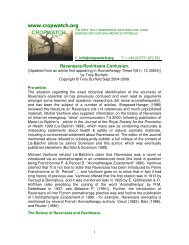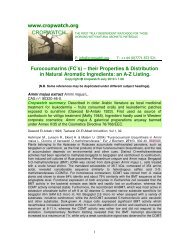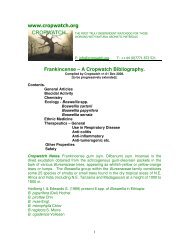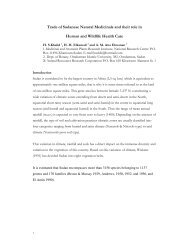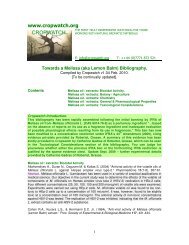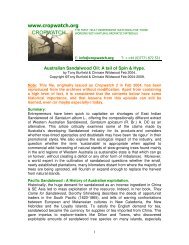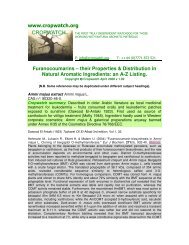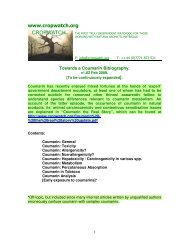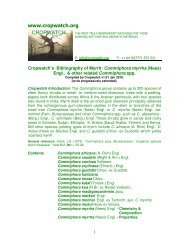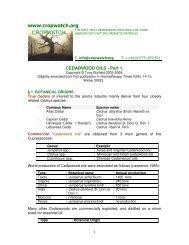Sandalwood Biblio - Cropwatch
Sandalwood Biblio - Cropwatch
Sandalwood Biblio - Cropwatch
Create successful ePaper yourself
Turn your PDF publications into a flip-book with our unique Google optimized e-Paper software.
epresent the first TPS genes to be isolated from sandalwood and will enable further elucidation<br />
of the oil biosynthesis genes.<br />
This thesis `completes a three-pronged approach to understanding the underlying causes of oil<br />
yield variance in S. album. As a species for which so little is known, the research presented here<br />
provides a major leap forward for tree improvement, breeding and silviculture. Hence the best of<br />
sandalwood research is presented.<br />
Jones C. (date) "Indian <strong>Sandalwood</strong>: Genetic and oil diversity and bio-chemistry of the<br />
Australian germplasm collection." <strong>Sandalwood</strong> Research Letter <br />
Jyothi, P. V., J. B. Atluri, et al. (1991). “Pollination ecology of Santalum album (Santalaceae).”<br />
Tropical Ecology 32(1), 98-104.<br />
Kababick J. P. (1996). “Evaluation on incense purity using simultaneous steam distillationextraction<br />
and HRGC analysis.” Journal of High Resolution Chromatography 19(4), 241-242.<br />
Kaikini N.S. (1969) “The Indian sandal wood.” My Forest 25-40 (1969).<br />
Kapoor M.L. (1981) “A technique for chromosome count from developing leaf buds of induced<br />
tetraploids & diploid Santalum album L.” Indian Forester 107, 290-300.<br />
Kawanishi Y., Nin K. & Toyoda K. (2004) “The influence on the autonomic nervous system of a<br />
preference for the smell of sandalwood” Aroma Research 5(4), 382-385.<br />
Khan M.M.., Faroqui A.A., Vasundhara M. & Srinisappa K.N. (1999) “Clonal propagation of<br />
sandalwood (Santalum album Linn.) PAFAI Journal 1, 20-24.<br />
Kulkami H.D. & Srithmathi R.A. (1981) “Polyembryony in the genus Santalum L.” Indian Forester<br />
107(11), 704-706.<br />
Kushalappa K.A. (1999) “Trade liberalization in sandalwood.” Indian Forester 125(9), 891-894.<br />
Madhi A. (1986) "The biology of S. album seed." Biotrop. Tech. Bull. 1(1), 1-9.<br />
Mathur, N.K. 1979. An annotated bibliography of spike disease of sandal (Santalum album Linn.)<br />
Forestry Research Institute. Dehra Dun. 74 p.<br />
Mayar R. (1988) “Cultivation Information, Exploitation & Protection of Santalum album.” Advances<br />
in Forestry research in India Vol II p117-152.<br />
Meera C., Nageswara Rao M., Ganeshaiah K.N., Uma Shankaar R. (2000) “Conservation of<br />
sanadal genetic resources I. Extraction patterns and threats to sandal resources in Karnataka.”<br />
My Forest 36(2), 125-132.<br />
Merlin M. & Van Ravenswaay D. “The history of human impact on the genus Santalum in<br />
Hawai’i.” Paper presented at the Symposium on <strong>Sandalwood</strong> in the Pacific, 1990. Abstract.<br />
Adaptive radiation of Santalum in the Hawaiian archipelago has provided these remote islands<br />
with a number of endemic species and varieties. The prehistoric Polynesian inhabitants of Hawai‘i<br />
utilized the sandalwood trees for many of the same traditional purposes as their South Pacific<br />
ancestors who had developed ethnobotanical relationships with Santalum. The ancient Hawaiians<br />
probably reduced the number and geographical distribution of sandal-wood trees<br />
significantly through their extensive cutting and burning, especially in the dry forest regions.<br />
Nevertheless, vast numbers of the fragrant trees still existed in Hawai‘i at the time of Western<br />
contact in 1778. Within a century after this contact, the extensive trade in sandalwood produced a<br />
massive decline in the Hawaiian species of Santalum. Although cultivation attempts during this<br />
cen-tury with both introduced and native sandalwood species have had limited success in<br />
Hawai‘i, there is renewed interest in developing a sustainable forest industry based on the<br />
production of sandalwood for export trade. Biologists in general, however, have cautioned against<br />
50





